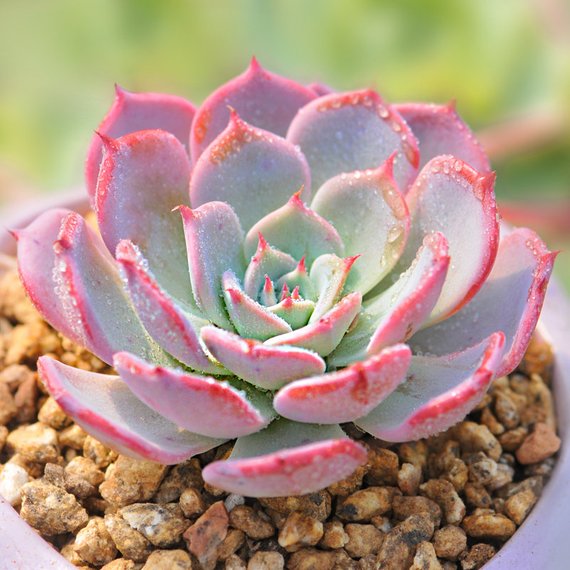Echeveria Laulensis is a type of succulent with thick stems that easily cluster and form old stumps, with single heads reaching up to 6-7cm. Its leaves are inverted-ovate, slightly thick, densely arranged in a rosette, ranging from grass green to bluish-gray in color with a thin powdery coating. The leaf tips are sharply pointed or have short points, and the leaf tips, edges, and backs can turn red when in an optimal state, with thickened leaves appearing orange-red.
Echeveria Laulensis blooms from late spring to early summer, with scorpion-tail-like inflorescences consisting of small bell-shaped five-petaled flowers, pink at the base and yellow at the top.
Characteristics: A medium-sized variety, easy to care for and branch out, with single-headed rosette-shaped plants. The leaves are inverted-ovate, slightly thin, inwardly curved, bluish in color with a slight powdery coating, and short-pointed at the front, with red edges and tips.
Growth habits and care methods for Echeveria Laulensis:
Echeveria Laulensis is easy to care for. In summer, it is important to provide partial shade, adequate ventilation, and control watering. Insufficient sunlight can cause it to turn green easily. Apart from partial shading in summer, Echeveria Laulensis can be grown in full sunlight or semi-shaded conditions during other seasons. The soil mix for Echeveria Laulensis should be loose and well-draining, such as peat/coconut husk and granular soil. Echeveria Laulensis can be propagated by leaf cuttings, with a high success rate, or by division or stem cuttings. For more care information about Echeveria Laulensis, refer to Blue Elf, another member of the Kalanchoe family.
Care:
Soil selection:
Caring for Echeveria Laulensis requires some attention to soil preparation. Although it grows relatively easily, the soil it is planted in should still be carefully chosen. Prepare some fertile humus soil to promote Echeveria Laulensis's growth. Humus soil is loose and well-draining, making it suitable for succulent cultivation. It can be mixed with some granular perlite, vermiculite, or granular materials.
Watering requirements:
Watering should be adjusted according to the seasons, as is the case with Echeveria Laulensis. During the vigorous growth periods of spring and autumn, the soil should be kept moist to ensure Echeveria Laulensis absorbs sufficient moisture, resulting in fuller and more upright leaves, making it more beautiful. However, watering should not be too frequent to avoid the risk of waterlogging. Generally, watering once every 5 days in winter and once every two weeks in summer is sufficient.
Light intensity:
Echeveria Laulensis is a succulent plant that loves sunlight. The more sunlight it receives, the faster its leaves will develop, becoming more compact, plump, and glossy. With adequate sunlight exposure, it will become more beautiful over time. Apart from shading and ventilation in summer, it can be placed in an outdoor area where there is sunlight. Sun exposure during the growth period promotes Echeveria Laulensis to sprout and grow lateral shoots through photosynthesis.
